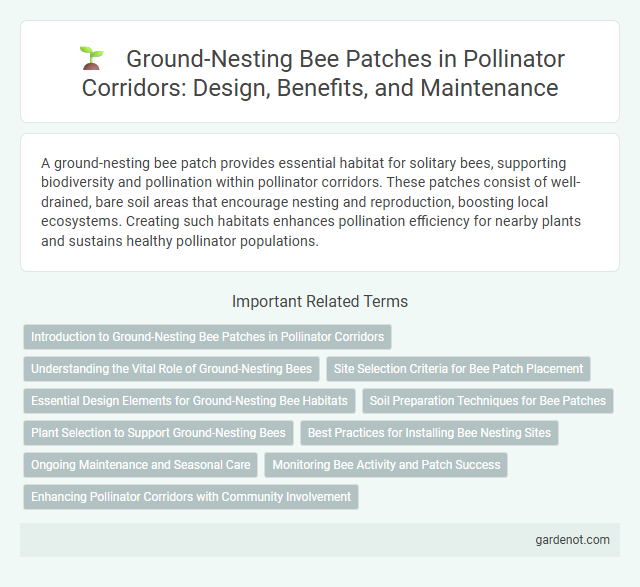A ground-nesting bee patch provides essential habitat for solitary bees, supporting biodiversity and pollination within pollinator corridors. These patches consist of well-drained, bare soil areas that encourage nesting and reproduction, boosting local ecosystems. Creating such habitats enhances pollination efficiency for nearby plants and sustains healthy pollinator populations.
Introduction to Ground-Nesting Bee Patches in Pollinator Corridors
Ground-nesting bee patches in pollinator corridors provide essential habitats for solitary bee species that nest underground, supporting biodiversity and enhancing pollination services. These patches consist of bare or sparsely vegetated soil areas with well-drained substrates, enabling ground-nesting bees to excavate tunnels for their nests. Incorporating such habitats within pollinator corridors helps sustain healthy bee populations crucial for agricultural productivity and ecosystem stability.
Understanding the Vital Role of Ground-Nesting Bees
Ground-nesting bees play an essential role in pollinator corridors by enhancing biodiversity and supporting ecosystem services. Their nesting habits improve soil aeration and nutrient cycling, which benefits plant health and crop productivity. Protecting and creating habitats for these bees ensures the sustainability of pollination networks critical for food security and environmental resilience.
Site Selection Criteria for Bee Patch Placement
Optimal site selection for ground-nesting bee patches involves well-drained, sandy or loamy soils with sparse vegetation to facilitate nesting and foraging activities. Areas receiving full sunlight and minimal disturbance from human activity or heavy foot traffic enhance bee population establishment and longevity. Proximity to diverse floral resources within 300 meters ensures adequate nutrition and supports pollinator corridor connectivity.
Essential Design Elements for Ground-Nesting Bee Habitats
Essential design elements for ground-nesting bee habitats include well-drained, bare or sparsely vegetated soil patches with sandy or loamy textures that facilitate easy burrowing. Incorporating south-facing slopes ensures warmth essential for bee development, while avoiding excessive mulch or dense vegetation maintains ground accessibility. Providing diverse native flowering plants nearby supports nutrition and encourages robust pollinator activity within the corridor.
Soil Preparation Techniques for Bee Patches
Soil preparation for ground-nesting bee patches involves loosening compacted soil to create a friable texture that facilitates easy burrowing. Incorporating organic matter such as compost improves soil aeration and moisture retention while avoiding heavy mulching that can obstruct nest entrances. Ensuring well-drained, sandy-loam soil with minimal vegetation allows ground-nesting bees to establish optimal nesting habitats within pollinator corridors.
Plant Selection to Support Ground-Nesting Bees
Selecting native wildflowers and grasses with open, shallow-root systems optimizes soil conditions for ground-nesting bees, enhancing their habitat within pollinator corridors. Incorporating species such as black-eyed Susan (Rudbeckia hirta), coneflower (Echinacea spp.), and native bunch grasses provides essential pollen and nectar resources while maintaining loose, well-drained soil preferred by ground-nesting bees like Andrena and Halictidae species. Avoiding dense mulch and invasive plants helps preserve suitable nesting substrates, promoting healthier bee populations and improved pollination services.
Best Practices for Installing Bee Nesting Sites
Creating a ground-nesting bee patch requires selecting well-drained, sandy or loamy soil with minimal vegetation to facilitate easy access for solitary bees. Site preparation should include removing debris and compacted layers while ensuring the area receives full sun exposure for optimal temperature regulation. Incorporating gentle slopes and maintaining undisturbed patches throughout the season enhances habitat suitability and promotes bee nesting success within pollinator corridors.
Ongoing Maintenance and Seasonal Care
Ground-nesting bee patches require consistent ongoing maintenance to ensure soil remains loose and free from compaction, promoting optimal nesting conditions for native bee populations. Seasonal care involves removing invasive plants and replenishing native wildflowers that bloom in early spring and late summer, supporting bees throughout their active periods. Monitoring moisture levels and avoiding pesticide use during critical nesting times further enhances habitat quality and pollinator health.
Monitoring Bee Activity and Patch Success
Monitoring bee activity in ground-nesting bee patches involves regular observations of nest entrances, flight patterns, and pollen collection to assess colony health and foraging efficiency. Detailed records of emergence rates and species diversity provide critical data for evaluating patch success and ecological impact. Integrating sensor technology and citizen science platforms enhances real-time monitoring, ensuring adaptive management of pollinator habitats.
Enhancing Pollinator Corridors with Community Involvement
Ground-nesting bee patches play a crucial role in enhancing pollinator corridors by providing safe nesting habitats essential for bee reproduction and population growth. Community involvement in creating and maintaining these patches supports biodiversity, improves local ecosystems, and promotes pollination of native plants and crops. Collaborative efforts increase habitat connectivity, ensuring sustainable pollinator networks that benefit agricultural productivity and environmental health.
Ground-nesting bee patch Infographic

 gardenot.com
gardenot.com